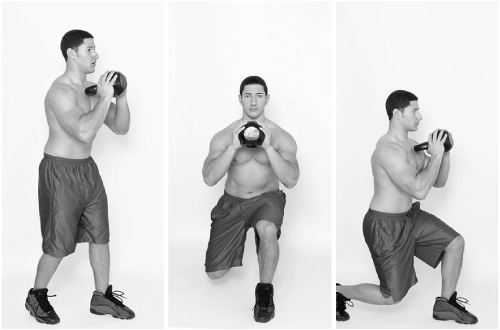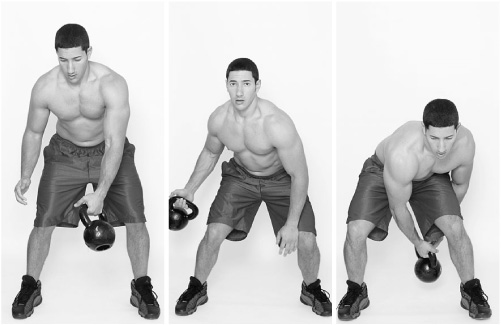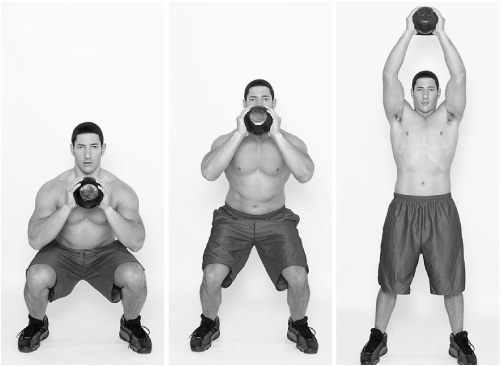
Week 5 of this program will make you feel as if your spouse has asked you to pass a few standard sobriety tests after you’ve been out all night with your friends. The kettlebell lunges, both forward and backward, and kettlebell passes will make you feel like you have never truly learned how to walk, but the strength and balance you develop will be well worth it. Add to this the weight and position of the kettlebells, and your lungs will be on fire as well as your muscles. With all of these exercises, take care to not allow your knee to move past the toes of your front foot. Otherwise, this creates a shearing force that your patellar tendon and your knee will probably not like.
The figure 8 is a movement fairly unique to kettlebell training. It is similar to dribbling a basketball over and over between your legs. You want to use your whole body and sway from side to side as well as forward and backward slightly. It teaches you to stay low for an extended period of time, which is valuable in many sports. It also teaches you how to move your hips from side to side. Both of these things work the muscles of the thighs and trunk well. I recommend that this exercise be performed with a moderate weight for more repetitions. This exercise works best in a lighter range than cleans, for example.
The squat-press is the cousin to the squat-pull. Body position is essentially the same, except that the weight is on the chest for the squat-press and is pressed overhead instead of pulled to the chest. This is a great movement for a football lineman or any athlete who needs to push from the ground up through the hands. The squat-press is sometimes used with the squat-pull as a stand-alone workout because almost all of the major muscle groups of the body are worked between these two exercises.
Last, you will perform the double floor press. This exercise is very similar to the dumbbell press, although the range of motion is somewhat shortened because this is performed from the floor. Your elbows stop just short of a complete range. This works well for athletes who have minor shoulder injuries. Also, the forearms and pectorals are required to be active throughout the movement to keep the kettlebells from falling outward, since they sit to the sides of the forearms instead of lining up directly with them.
For the kettlebell back lunge, you can use either one or two kettlebells. They can be cleaned to a racked position, they can be at your sides, or a single kettlebell can be resting on your chest. Looking straight ahead, step back slightly farther than you would for a normal stride. Your front foot should remain flat, and your back foot should be on its toes. Bend your back knee first to keep your body upright, and drop as close as you can to the floor without touching. Both your back and front knees should be at right angles. Bring the back leg forward to the starting position, and then step back with the opposite leg. Continue to alternate until your set is complete.
Kettlebell Lunge Whether you are lunging forward or backward, it is very important to work in right angles. Both knees should be bent to 90 degrees at the midpoint of any lunge. Failure to adhere to this rule will result in an irritation of your patellar tendons and soreness in your knees. The easiest way to keep your knees working at this angle is to take a moderate to large stride and to bend your back knee slightly before your front knee regardless of the direction of the lunge. Also, note that the model is looking straight ahead. Doing this helps you keep from leaning forward.
KETTLEBELL BACK LUNGE: KEY POINTS
1. Decide on using one or two kettlebells and whether they will be at your chest, shoulders, or sides.
2. Look straight ahead, and step back with one leg.
3. Keep your front foot flat and your back foot on its toes.
4. Bend your back knee first, and drop down as close as you can to the floor without touching. Both knees should be bent to right angles.
5. Step forward with your back leg, and step back with the opposite leg.
6. Continue to alternate legs until the set is complete.
Caution: To avoid unnecessary stress on your knees, your front knee should not move beyond the toes of the same leg.
Like the kettlebell back lunge, the kettlebell forward lunge can be performed with one or two kettlebells and held either at the chest, shoulders, or sides. You use the same series of movements as for the kettlebell back lunge, except you step forward. All lunges can be performed while either stationary or walking. I do, however, recommend avoiding backward walking lunges unless you have excellent balance and have experience with this exercise.
The kettlebell pass is similar to a kettlebell forward lunge, although it is always performed with one kettlebell. Start the movement with the side that is not holding a kettlebell. As you step forward and your front knee bends, pass the kettlebell under your knee to your free hand. Then step with the other side, and pass it back. Continue to alternate sides in this fashion. Look straight ahead or slightly down as you perform this exercise. Also, try to keep a fairly straight back. This exercise works the muscles of the legs, shoulders, and back. It is especially good for developing coordination for sports that require you to move with and around an object, such as wrestling, judo, and jujitsu.
This exercise can be performed forward, backward, and diagonally. Experiment with different combinations of directions such as two steps backward followed by one step forward, diagonally in each direction. Repeat this drill several times to get used to changing directions.
Kettlebell Pass Think of the kettlebell pass as a lunge variation with a shortened range of motion. Your knees do not bend nearly as much as in a traditional lunge, but you still bend forward to coordinate the kettlebell passing behind your knee. This exercise is all about timing. As your knee bends, the kettlebell should be moving behind it. As you take your next step, the kettlebell should be coming up to prepare for the next pass.
KETTLEBELL PASS: KEY POINTS
1. Begin by holding one kettlebell at your side.
2. Step forward with your free side.
3. Keeping your back flat, bend your front leg.
4. Pass the kettlebell underneath your front knee to your free hand.
5. Pass the kettlebell back and forth underneath your front knee as you step.
The figure 8 is a fun exercise that is good for developing strength in your trunk and hips. Just as it sounds, the kettlebell moves around your legs in a figure 8 pattern. Begin by positioning your feet slightly wider than your shoulders. Using a moderate weight, begin with a backswing between your knees. Instead of bringing the kettlebell forward, move your hips to one side and pass the kettlebell behind that knee. As your free hand takes the weight, bring the kettlebell around the outside of your leg and then back between your knees. As the kettlebell passes between your knees, lean to the opposite side and pass the kettlebell behind that knee. Continue to move the kettlebell in a figure 8 pattern until your set is complete. As you perform this exercise, look down at an angle of approximately 45 degrees and keep your back flat. Also, squat down slightly throughout the movement. This exercise is to be performed for a fairly high number of repetitions—usually 20 or more.

Figure 8 Bring the kettlebell straight back between the knees when performing the figure 8. Then take it to the outside and behind the knee for the pass. This gives you a little extra room to keep from banging the kettlebell into your shin. Also, your hips should be moving side to side with the kettlebell. This helps bend your knee and make a gap for the kettlebell to move through.
FIGURE 8: KEY POINTS
1. Stand with your legs slightly wider than shoulder-width apart.
2. Begin movement with a backswing.
3. Shift your hips to one side, and pass the kettlebell behind that knee.
4. Circle your leg to the front; then pass between your knees.
5. Hand off to your free hand behind the opposite knee.
6. Continue to move in a figure 8 pattern.
Caution: Make sure you have trimmed nails, as they might get caught when changing hands with the weight.
This exercise can be performed with either one or two kettlebells. If using two, clean them to your shoulders. If using one, rest the kettlebell on your chest with the handle facing your body. Make sure to wrap your thumbs around the handle to secure the weight.
Looking straight ahead, bend your knees as far as you are able (your goal should be to get your thighs parallel to the ground), and then extend your knees and hips. When you reach a fully erect position, continue the movement by pressing the kettlebell(s) overhead. Pause briefly, and then lower the kettlebell(s) to your starting position. As soon as the weight makes contact with your body, drop down into the next repetition.

Squat-Press The key point to remember about the squat-press is that both the downward and upward phases should be performed smoothly. The entire movement from the bottom of the squat to the full extension of the press should be executed in one nonstop motion. The same is true for going back down, from the top of the press to the bottom of the squat. Also, as with most overhead exercises, press the kettlebells to full extension without allowing them to drift forward at the top.
1. Position yourself with either one kettlebell on your chest or one on each shoulder in a racked position.
2. Look straight ahead, bend your knees, and then bend your hips, dropping into a deep squat.
3. Press your feet into the floor, and explode out of the bottom position.
4. When you are standing erect, follow through into the press.
5. Pause and then lower the kettlebell(s) to the starting position.
6. As soon as the weight makes contact with your body, drop into the next repetition.
Set two kettlebells on the floor slightly wider than shoulder-width apart. Lay down between the kettlebells so they are lined up with your midsection. Slide your hands through the handles with your palms up, and pull the weights to your chest. As with the single floor press, turn your elbows out so your arms are perpendicular to your body. Keeping your knees bent and your feet flat on the floor, press both kettlebells to a full extension and center them over your chest. Pause briefly, and then slowly lower the weights until your elbows gently touch the floor. Keeping the muscles of the chest, shoulders, and triceps tight, pause briefly once again and then press the kettlebells back up for the next repetition.
Caution: If you are exercising on a hard surface, use a mat or some towels to cushion the floor.
Double Floor Press The double floor press calls for two kettlebells to be pressed at the same time. Balance is challenged less in the double press versus the single press; however, you now have the ability to add a significant amount of weight and give your upper body a great workout. As you press, remember to center the kettlebells at the top to maximize the range of motion.
DOUBLE FLOOR PRESS: KEY POINTS
1. Set two kettlebells on the floor slightly wider than shoulder-width apart.
2. Lay between the weights so the handles line up with your midsection.
3. Slide your hands through the handles, palms up.
4. Pull the kettlebells to your chest, and turn your elbows out.
5. Press to full extension over the center of your chest.
6. Pause at the top, and then lower slowly until your elbows lightly touch the floor.
7. Pause at the bottom while keeping tension in your chest, shoulders, and triceps.
8. Press into the next repetition.